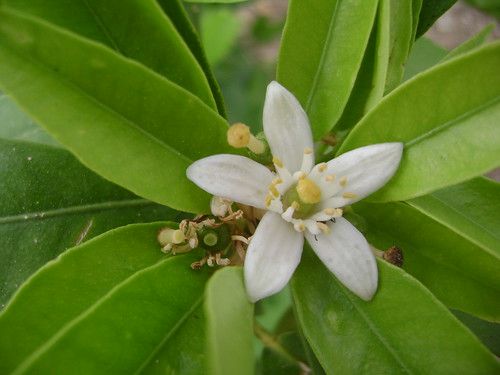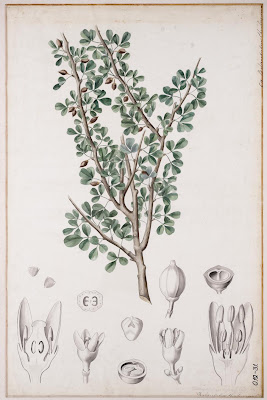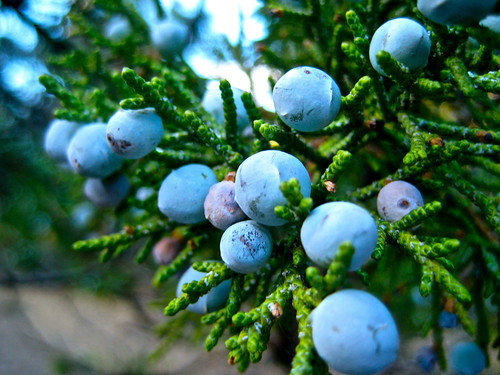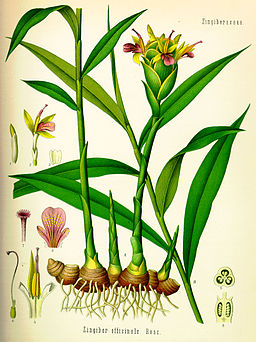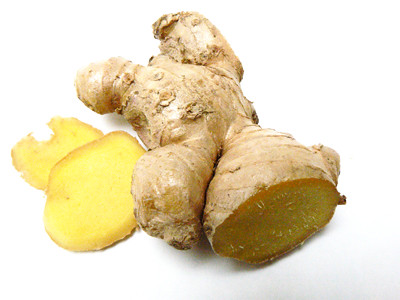"I had a little nut tree,
Nothing would it bear
But a silver nutmeg,
And a golden pear;
The King of Spain's daughter
Came to visit me,
And all for the sake
Of my little nut tree.
Her dress was made of crimson,
Jet black was her hair,
She asked me for my nut tree
And my golden pear.
I said, "So fair a princess
Never did I see,
I'll give you all the fruit
From my little nut tree."
This nursery rhyme
historically referrs to the visit of the Spanish princess Catherine of Aragon (one of the two daughters of Queen Isabella and King Ferdinand of Spain), who later became Kind Henry the VIII's first wife. Aside from the historical context, the reader gets the sense of the preciousness of the
nutmeg spice from this rhyme, and a subtle hint to its aphrodisiac qualities – as if having a tree bearing such a precious (silver!) nut is what got the princess visiting from far away land. And such a tree, bearing two species of fruit is of course not realistic. However, the British has an interesting role in the history of the nutmeg – although they weren’t by any means the first Europeans to discover it.
Nutmeg (Myristica fragrans) is the fruit of a tropical tree native to the Banda Islands of Indonesia. It is said that birds flying above the nutmeg islands get intoxicated from the fragrance emanating from the trees. And indeed, nutmeg has potent psychoactive properties that should be underestimated, due to its high
myristicin content (between 0.2-1.3%). It also contains elemicin and safrole. In mace (the lace that covers the nut itself) the safrole content is even higher, making it less safe to use for children and pregnant women (it is an abortifacient, and was used as such in the 19th century, leading to increased cases of myristicin poisoning). Thankfully, the amounts required to flavour a dish are still safe. But if you’ve ever had the pleasure to have a whole nutmeg in a smoothie (which I did, at one time, when ordering a fresh banana & nutmeg smoothie at
Bliss in Vicotria). It had similar effect as a full shot of rum… Not exactly what I was aiming for at high noon!
Nutmeg’s intoxicating effects were put to use in its country of origin, where it was powdered and used as snuff all on its own; and in India it was mixed with betel and other herbs for snuff. In medieval times, the lady of the house would carry a nutmeg and a silver grater and by nightfall, she will prepare a nightcap with steamed milk and grated nutmeg on top. Nutmeg infused brandy was prepared by grinding several nuts and infusing them in brandy for 2 weeks. A few of these drops were added to steam milk for a nightcap or as an aphrodisiac.
The location of the Banda islands was kept secret by the Arab traders, who sold nutmeg to the Venetian aristocracy until 1511, when Afonso de Albuquerque, an admiral and the colonial governor of Portuguese India, has found their location. He was able to take enough nuts with him to sell to Europe, but he was unable to take monopoly over the nutmeg trade – the Dutch were the ones to claim that honour, and had full control over nutmeg and mace until the 17th century. They kept the prices high by burning excess crops in their warehouses in Amsterdam. After two wars with England (the second spanning from 1665-1667), England and the United Provinces of Netherlands signed the Treaty of Breda, in which the
Island of Run in Indonesia (the secret source of nutmeg trees) was abandoned by the English, and the Island of Manhattan was given to England, and the name of the city on it – New Amsterdam – was changed to New York. However, the English have captured Bandalontor in 1810 and transferred nutmeg trees to other places (Ceylon, Grenada, Singapore and other colonies) in 1817, thus ruining the Dutch monopoly on nutmeg.
Interestingly enough, a nutmeg butter can also be produced – similar in character to cocoa butter, only with a faint aroma of nutmeg. Many nutmegs, however, have their fatty parts eaten by certain worms that stay away from the potent essential oils. While these nuts may not be appealing visually, they are perfectly fit for oil distillation. Nutmeg butter finds its uses mostly in soap and candle-making.
Due to its shape, closely resembling the human brain, nutmeg was associated with the head,and was used to treat headache and other head and nerve related ailments in Ayurveda, Tibetan medicine as well as European herbalism. Nutmeg is considered comforting to the head and nerves, warming and soothing, relieving anxiety and restlessness. It is used in treating many different ailments in aromatherapy and herbalism, such as arthritis, muscle pain and rheumatism; nausea and indigestion; bacterial infections (it was also used in fumigants – though not with enough success – to suppress the plague); and helps to combat nervous fatigue, frigidity and impotence.
The essential oil of nutmeg is a clear brown and mobile. The solvent-extracted absolute is a semi-viscous clear brown liquid. Nutmeg essential oil is peppery, a tad campohreous, and also could have a hint of rubbery smokiness to it (that characteristic is present when the oil is fresh, and should disappear after a while). Nutmeg absolute is warm, sweet, balsamic, almost buttery, custard-like (because of the eggnog association), not nearly as camphoreous as the oil, and really quite scrumptious. Both materials are used in perfumery and flavouring. Oriental perfumes benefit from nutmeg’s sensual, warm and sweet fragrance that lends itself so well to florals and is used in carnation compounds (the iso-eugenol being the main characteristic of both carnation and nutmeg).
In flavour, nutmeg is an excellent masking qualities for unpleasant odours from cabbage and meats, and used in sauces, preserves and pickle flavouring. With its rich history in the spice trade, it is no surprise that the nutmeg has become such an integral part in so many cuisines – in Malaysian Penang cuisine; in Arabic and North African spice mixtures such as Baharat (Arabia), Hawaij (Yemen),
Ras el Hanout (Morocco) and many East Indian and West Indian spice mixtures and dishes, such as curries, spiced rum and even chai tea blends. It is also used in the relatively milder Japanese curries. In Greek it is called “musky nut” and in Hebrew it is called “muskat” – referring to its sweet and complex aroma. The Dutch used nutmeg and mace in vegetable dishes (Brussels sprouts, cauliflower and green beans), and in most of Europe it’s traditionally paired with potatoes and meet stews, as well as mushroom and spinach and white sauces.
Eggnog Crème Brûlée:Adapted from
Dorie Greenspan’s
"Paris Sweets"
I made this in the holiday season of 2011, and this was the 1st time it worked for me (my first try at a creme brulee was grainy, unfortunately; something you can easily avoid by properly tempering your egg yolks - muster all the patience you got!).
The sweet, warm nutmeg aroma paired with an overdose of liquor (usually one tablespoon is the maximum amount for that size of recipe). It was fantastic, with that boozy feel-good quality of a rum-spiked eggnog. I'm sure that infusing the cream with a whole nutmeg got something to do with it... It has the taste, smell and texture of an aphrodisiac. Delight for all the senses, to be sure.
3 egg yolks1-1/4 cups whipping cream1/2 cup whole milk1/3 cup + 1 Tbs evaporated or raw cane sugar1 whole nutmeg, cracked with a side of a chef’s knife1/2 vanilla bean, sliced lengthwise with the seeds scraped 3 Tbs. Rum3 Tbs. BrandyAdditional evaporated cane sugar for burningStep 1: Preheat the oven to 200F
Step 2: Dissolve the milk and cream with the sugar in a saucepan over medium heat
Step 3: Infuse the nutmeg and vanilla bean (including scraped seeds, of course!) with the milk, cream and sugar mixture, over medium to low heat, stirring constantly with a wire whisk. When reaching boiling point, remove from heat and cover with a lid so the liquids get thorouighly infused with the spices.
Step 4: Beat the egg yolks
Step 5: Temper the egg yolks: Add a little bit of the warm liquids to the egg yolks and beat them well. Add some more and beat again. Pour the egg yolks into the entire mixture and stir well with a wire whisk.
Step 6: Add the rum and brandy and stir well.
Step 7: Strain the custard mixture through a sieve or a tea strainer into a large measuring cup or a pitcher. Place 6 small ramekins on a baking sheet. Divide the custard between the ramekins.
Step 8: Bake for 50-60 minutes, until the centres of the custards are set. They should not wiggle much when moved around.
Step 9: Cool at room temperature, and then refrigerate for 3 hours or up to 2 days.
Step 10: Sprinkle with additional sugar, and just before serving, burn the sugar with a small blow torch. Serve immediately, while the burnt sugar is still hot!
Aphrodisiac perfumes containing nutmeg - there are really too many to count, so I'm just skimming through here:
Black Angel (Mark Buxton),
Comme des Garcons 2 Man,
Coriolan (Geurlain),
Fête d'Hiver (Ayala Moriel), Grey Vetiver, Noir Epices (Michael Roudnistka for Editions de Parfums), Obsession for Men (Calvin Klein),
The Purple Dress (Ayala Moriel), Rivertown Road (Liz Zorn Soivhole), Rocabar (Hermès),
Roses et Chocolat (Ayala Moriel),
Scarlet Lurkspur (Ineke's Floral Curiosities),
Soir de Lune (Sisely) Sounds & Visions (Mark Buxton), Spezie (Lorenzo Violloresi), St. Valentine's (DSH Perfumes),
Sushi Imperiale (Bois 1920), Vetiver (Guerlain),
Vetiveryo (Diptyque) Vetiver Racinettes (Ayala Moriel),
Vitriol d'Oeillet (Serge Lutens)


